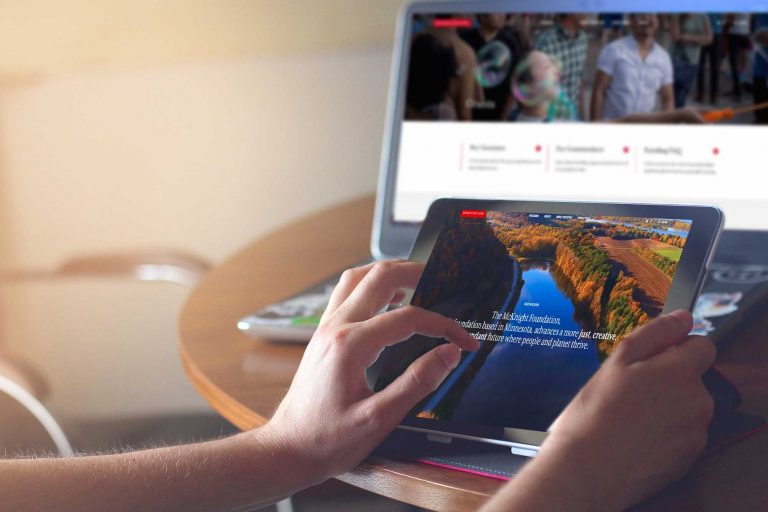This post was originally published on Transparency Talks, the GlassPockets blog site on April 11, 2019. It is reprinted here with full permission
The McKnight Foundation is proud to be among the early group of foundations that joined the GlassPockets movement and has benefited from its tools and resources. As GlassPockets crosses the threshold of 100 foundation transparency profiles on its website, I wanted to share a personal reflection on how McKnight approaches transparency on our website, and how GlassPockets has been part of that journey.
When I decided on a redesign of our website about a year ago, I knew that there was a great body of knowledge we could tap into by reviewing GlassPockets tools and content, so I scheduled a call with Janet Camarena, who leads the website and initiative to encourage greater foundation transparency. In this new version of our web presence, I wanted to design for transparency from the start. GlassPockets didn’t disappoint, and Janet offered a helpful perspective from her years of observing the paths and barriers faced by our peers on the road to transparency.
While the word transparency can sometimes feel like a clinical term, Janet explained that transparency and openness can humanize institutions through the power of storytelling, and we all know foundations have powerful stories about the impact of their grantees. When I asked her about the common tendency of foundations to embrace a stance of humility, she nodded. She said she often hears that humility can stand in the way of embracing a “GlassPockets approach,” preventing us from seeing storytelling as an act of public service, rather than as self-serving content.
This conversation reaffirmed for me one of the core benefits of foundation transparency: when the public knows more about what foundations fund and how they approach their work, trust is built, advancing the entire field of philanthropy, the nonprofits we support, and our collective impact.
How McKnight Advances Transparency with its Website
A key purpose for our foundation website is pragmatic and impactful transparency. With our web developer, Visceral, we tried to make our site as fun to peruse and simple to navigate as possible, and we packed it with information to help people conduct practical business. For example, we now include all the details on how to seek funding, how to reserve a meeting space, and even the investments we make in our impact investing portfolio. We also have a robust, easy-to-search grants database, which makes us a rarity among national funders. According to the GlassPockets’ Transparency Challenge, only about one of every 100 foundations shares current grants data online. Lists of grants, combined with compelling images and vignettes throughout the site, help others to better understand our organization’s mission.
“…when the public knows more about what foundations fund and how they approach their work, trust is built, advancing the entire field of philanthropy, the nonprofits we support, and our collective impact.”
—NA ENG, COMMUNICATIONS DIRECTOR
In addition, I’ve come to realize that providing more information does not necessarily achieve greater transparency. It’s as essential to offer an updated, accurate representation of work—and that means clearing the clutter. (Consider the KonMari method of thanking what no longer has value, and then letting go.) External websites should not be used as an internal digital archiving system. We’ve learned that dated content often caused confusion about our current purpose and identity. However, for scholarly use, we do archive older reports with IssueLab, which has an impressive open knowledge-sharing system.
Digital Accessibility & Linguistic Inclusion
Transparency also requires understanding the needs of diverse audiences and making digital inclusion a priority. When we set out for our site to be more user-friendly for people who are hard of hearing or blind, we commissioned an accessibility audit. And rather than rely on web-based scanners, we asked people who had the relevant disabilities to evaluate its accessibility level. Among the changes, we added closed captioning to all our videos, at little cost. We’ve since expanded closed captioning to more than a dozen languages, all spoken in our home state of Minnesota, including Hmong, Laotian, Somali, Oromo, Arabic, Chinese, Spanish, and others.
Our efforts toward digital inclusion, which enable transparency for people with different physical and linguistic abilities, are ongoing. We still have much to learn. We´re now learning more about the technical needs of people in low-bandwidth zones in the developing world, rural communities, and even in pockets of metro areas. When most digital communications are designed for able-bodied English language speakers who have access to high-speed internet, significant population groups are cut off from the ideas and opportunities we offer, and we’re deprived of the chance to connect with people who have so much to contribute to advancing our mission.
Our society often thinks of discrimination in terms of individual actions, giving scant attention to systemic barriers. These are insidious obstacles created and maintained, often unintentionally, even by people of goodwill—simply because they’re not aware of the impact of these barriers on those who are not just like them.
The website of an organization that has the power to distribute resources, bestow awards, and select new staff and partners can be an instrument for perpetuating or disrupting inequity. And when a foundation has important ideas to spread—in our case, ideas about advancing a just, creative, and abundant future where people and planet thrive— a website can leave people behind… or it can inspire more people to advance the mission.
Thankfully, we have movements like GlassPockets urging us all to move toward more pragmatic, inclusive, and impactful transparency.


